Australian rules football
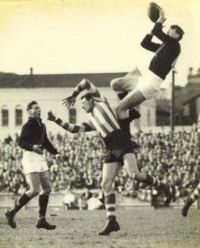 High marking (catching the ball high in the air) is a key skill in Australian Rules Football |
|
| Highest governing body | Australian Football League |
|---|---|
| Nickname(s) | Australian football (official name), Australian rules football, football, footy, Aussie rules, AFL (erroneously) |
| First played | 1858, Melbourne, Australia |
| Registered players | 650,394 (total) 130,000 (adult) (2007) |
| Clubs | 2,650 |
| Characteristics | |
| Contact | Contact |
| Team members | 22 |
| Mixed gender | Single |
| Category | Outdoor |
| Ball | Football |
Australian (rules) football, or simply known as football, footy, Aussie rules or (erroneously as) AFL, is a team sport played between two teams of 18 players with a ball in the shape of a prolate spheroid. It is a football variant played outdoors on large oval shaped grass fields (often also used as a cricket ground), with four goal posts at each end.
The primary aim of the game is to score goals by kicking the ball between the middle two posts of the opposing goal. The winner is the team who has the higher total score at the end of the fourth quarter.[1] Except for special circumstances[2], if the score is tied then a draw is declared.
Players may use any part of their body to advance the ball. The primary methods are kicking, handballing and running with the ball. There are restrictions on how the ball can be handled, for example players running with the ball must intermittently bounce or touch it on the ground, throwing the ball is not allowed and players must not get caught holding the ball. Unlike most similar sports, there is no offside rule and players can roam the field freely. Possession of the ball is in dispute at all times except when a free kick is paid. A distinctive feature of the game is the mark, where players anywhere on the field who catch a ball from a kick (with specific conditions), are awarded a free kick[3]. Australian rules is a contact sport in which players can tackle using their hands or use their whole body to obstruct opponents. Dangerous physical contact (such as a pushing an opponent in the back), interference when marking and deliberately slowing the play are discouraged with free kicks, distance penalties or suspension, depending on the seriousness of the infringement. Frequent physical contests, aerial marking or "speckies", fast movement of both players and the ball and high scoring are the game's main attributes as a spectator sport.
Details of the game's origins in Australia are obscure and still the subject of much debate. Accounts of various forms of "foot-ball" being played in the Victorian goldfields that shared similar attributes to Australian football date back to 1853. Australian football became organised in Melbourne in 1858 with a series of experimental rules in a bid to keep cricketers fit during the winter months and in 1859 the first laws of the game were published by the Melbourne Football Club.[4]
Today Australian rules football is the most popular spectator sport in Australia[5][6] and is played extensively with competitions in all Australian states and two territories. While it is a professional sport only in Australia, it is played at amateur level in several countries and in several variations. The most prestigious and only national competition in Australia is the Australian Football League (AFL), which culminates in the annual AFL Grand Final, the highest attended club championship event in the world in 2005, 2006, 2007 and 2008.[7] The league has governed the sport through the AFL Commission and the AFL Rules Committee, since it disbanded the Australian National Football Council in 1993 and International Australian Football Council in 2002.
In 2008, the 150th anniversary of the first recorded games of Australian football are being celebrated. Organised events include the publishing of an official history in a book titled The Australian Game of Football [8], the AFL Hall of Fame Tribute Match, events at many community based football clubs, the 2008 Australian Football International Cup and the return of the International Rules Series.
Contents |
Rules of the game
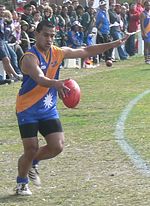
Both the ball and the field of play are oval in shape. No more than 18 players of each team are permitted to be on the field at any time.
Up to four interchange (reserve) players may be swapped for those on the field at any time during the game. In Australian rules terminology, these players wait for substitution "on the bench" - an area with a row of seats on the sideline.
There is no offside rule nor are there set positions in the rules; unlike many other forms of football, players from both teams disperse across the whole field before the start of play. However, only four players from each team are allowed within the 45 m centre square before every centre bounce, which occurs at the commencement of each quarter, and to restart the game after a goal is scored. There are also other rules pertaining to allowed player positions during set plays (i.e., after a mark or free kick) and during kick-ins following the scoring of a behind.
A game consists of four quarters. In professional Australian Football, quarters are 20 minutes plus time on. In the AFL, quarters are 20 minutes, the clock is stopped when the ball is out of play, meaning that an average quarter could last for 27 to 31 minutes. At the end of each quarter, teams change their scoring end.
Games are officiated by umpires. Australian football begins after the first siren, the umpire bounces the ball on the ground (or throws it into the air if the condition of the ground is poor), and the two ruckmen (typically the tallest players from each team), battle for the ball in the air on its way back down.
The ball can be propelled in any direction by way of a foot, clenched fist (called a handball or handpass) or open-hand tap but it cannot be thrown under any circumstances. Throwing is defined in the rules quite broadly but is essentially any open hand disposal that causes the ball to move upward in the air.
A player may run with the ball but it must be bounced or touched on the ground at least once every 15 metres. Opposition players may bump or tackle the player to obtain the ball and, when tackled, the player must dispose of the ball cleanly or risk being penalised for holding the ball. The ball carrier may only be tackled between the shoulders and knees. If the opposition player forcefully contacts a player in the back whilst performing a tackle, the opposition player will be penalised for a push in the back. If the opposition tackles the player with possession below the knees, it is ruled as a low tackle or a trip, and the team with possession of the football gets a free kick.
If a player takes possession of the ball that has travelled more than 15 metres from another player's kick, by way of a catch, it is claimed as a mark and that player may then have a free kick (meaning that the game stops while he prepares to kick from the point at which he marked). Alternatively, he may choose to "play on:" forfeiting the set shot in the hope of pressing an advantage for his team (rather than allowing the opposition to reposition while he prepares for the free kick). Once a player has chosen to play on, normal play resumes and the player who took the mark is again able to be tackled.
There are different styles of kicking depending on how the ball is held in the hand. The most common style of kicking seen in today's game, principally because of its superior accuracy, is the drop punt (the ball is dropped from the hands down, almost to the ground, to be kicked so that the ball rotates in a reverse end over end motion as it travels through the air). Other commonly used kicks are the torpedo punt (also known as the spiral or screw punt; the ball is held at an angle and kicked, which makes the ball spiral in the air, resulting in extra distance) and the checkside punt or "snap", used to curve the ball towards targets that are on an angle.
Apart from free kicks or when the ball is in the possession of an umpire for a ball up or throw in, the ball is always in dispute and any player from either side can take possession of the ball.
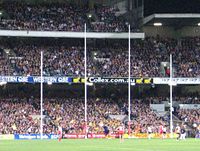
A goal is scored when the football is propelled through the goal posts at any height (including above the height of the posts) by way of a kick from the attacking team. It may fly through on the full or bounce through, but must not have been touched, on the way, by any player from either team. A goal cannot be scored from the foot of an opposition (defending) player.
A behind is scored when the ball passes between a goal post and a behind post at any height, or if the ball hits a goal post, or if an attacking player sends the ball between the goal posts by touching it with any part of the body other than a foot. A behind is also awarded to the attacking team if the ball touches any part of an opposition player, including his foot, before passing between the goal posts. When an opposition player deliberately scores a behind for the attacking team (generally as a last resort, because of the risk of their scoring a goal) this is termed a rushed behind.
If the ball hits one of the behind posts, the ball is considered out of bounds and no score is awarded.
A goal is worth 6 points whereas a behind is worth 1 point. The Goal Umpire signals a goal with two hands raised at elbow height, a behind with one hand, and then confirms the signal with the other goal umpire by waving flags above his head.
The team that has scored the most points at the end of play wins the game. If the scores are level on points at the end of play, then the game is a draw; extra time applies only during finals matches in some competitions.
As an example of a score report, consider a match between St Kilda Football Club and the Sydney Swans. St Kilda's score of 15 goals and 11 behinds equates to 101 points. Sydney's score of eight goals and ten behinds equates to a 58 point tally. St Kilda wins the match by a margin of 43 points. Such a result would be written as:
- St Kilda Football Club 15.11 (101) defeated Sydney Swans 8.10 (58);
and said,
- "St Kilda fifteen eleven, one hundred and one defeated Sydney Swans eight ten, fifty-eight."
Structure and competitions
- See also: Australian rules football around the world

The football season, proper, is from March to August (early autumn to late winter in Australia) with finals being held in September.[9] In the tropics, the game is sometimes played in the wet season (October to March)[10]. Pre-season competitions in southern Australia usually begin in late February.
The AFL is recognized by the Australian Sports Commission as being the National Sporting Organisation for Australian rules football[11]. There are also seven state/territory-based organisations in Australia, most of which are now either owned by or affiliated to the AFL.[12]
Most of these hold annual semi-professional club competitions while the others oversee more than one league. Local semi-professional or amateur organizations and competitions are often affiliated to their state organisations.
The AFL is also the de facto world governing body for Australian rules football. There are also a number of affiliated organisations governing amateur clubs and competitions around the world[13].
For almost all Australian rules club competitions the aim is to win the Premiership. The premiership is always decided by a finals series. The teams that occupy the highest positions on the ladder play off in a "semi-knockout" finals series. From the 1930s the finals series was usually contested by the top 4 teams (3rd versus 4th (First semifinal); 1st versus 2nd (Second semifinal); winner of First versus loser of Second (Preliminary final); the winner of Second versus winner of Preliminary playing in the Grand Final for the premiership). Many leagues have adopted a final series involving 5, 6 or 8 teams with a variety of methods used to determine the winner. The AFL finals system is contested by the top 8 teams.
Unlike most soccer competitions there are usually no separate "league" and "cup" trophies. The team finishing first on the ladder is often referred to as a 'minor premier', although this bears little or no significance. In the AFL, this is the McClelland Trophy[14] and is considered a consolation prize. The team which finishes at the bottom of the ladder at the end of the season is said to receive 'the wooden spoon'[15] It is also rare for promotion and relegation to occur in Australian rules football competitions.
History
Origins of the Game
- See also: The Origins of Australian rules football
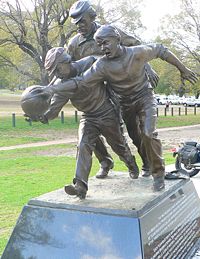
There is evidence of several unique forms of "foot-ball" being played in the Victorian gold fields which may have shared a range of influences. The Geelong rules began to take shape around 1856, although there are no existing written records. The Melbourne rules were formed through a series of experimental matches and eventually became dominant.
A letter by Tom Wills was published in Bell's Life in Victoria & Sporting Chronicle on 10 July 1858, called for a "foot-ball club" with a "code of laws" to keep cricketers fit during winter[16] is widely regarded as the most significant milestone in the organisation of Australian football. It was during 1858 that references to the first "foot-ball" clubs in Melbourne began to appear, including Richmond Cricketers, St Kilda and Melbourne. Wills' letter attracted football players to an experimental match, at the Richmond Paddock (later known as Yarra Park next to the MCG) on 31 July 1858. Few details of the match have survived, though it is known that Wills both played in and umpired the game.
On 7 August 1858 a famous match between Melbourne Grammar School and Scotch College began at Richmond Park, which was umpired by Wills and McAdam and also involved Scotch headmaster Thomas H. Smith[17]. A second day of play took place on 21 August and a third, and final, day on 4 September.[18] While the full rules that were used is unknown, the match was played with a round ball, the distance between the goals was approximately half a mile (approximately 4 times longer than the modern MCG playing surface), there were 40 players per side and one goal each side was scored with the game being declared a draw. The two schools have competed annually ever since for the Cordner-Eggleston Cup.[19]
Some regard these early matches as the first matches of Australian Football, however to many it is clear that the game was still in the process of evolving.
First rules
- See also: History of Australian rules football in Victoria (1859-1900)
The Melbourne Football Club rules of 1859 are the oldest surviving set of laws for Australian football. The ten simple rules were drawn up on 17 May in a meeting was chaired by Wills and in attendance were journalists W. J. Hammersley and J. B. Thompson.[18] Accounts of the people directly involved differ. Some sources also claim that Thomas H. Smith[20] and H. C. A. Harrison[21] were also present. The meeting was held at the Parade Hotel, East Melbourne hosted by owner and Melbourne Cricket Club member Jerry Bryant. The publican was a friend of Tom Wills with a personal interest in introducing football to Melbourne's schools. Bryant had played a role in organising early football matches at the nearby Richmond Park and his son was one of the first players.[22] The rules were signed by Tom Wills, William Hammersley, J. Sewell, J. B. Thompson, Alex Bruce, T. Butterworth and Thomas H. Smith. Importantly, the rules were widely publicised and distributed.
Early competition in Victoria
- See also: List of Australian rules football clubs by date of establishment
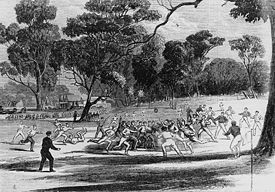
The Champion of the Colony (precursor to the Brownlow Medal) is an individual football award which was first granted in 1858.
Notably in 1859 several new football clubs formed including the Castlemaine Football Club, Geelong Football Club (which Wills directly helped to form) and the Melbourne University Football Club. While many one-off matches are recorded to have taken place between several early teams from Melbourne's suburbs and country Victoria (such as the Ballarat and Geelong competitions), in the early days many had not yet formed clubs for regular competition.
The first ever trophy for Australian Football, awarded by the Royal Caledonian Society of Melbourne and played under the Melbourne Rules was contested in 1861 between the Melbourne Football Club and Melbourne University, and was won by University. The competition continued into the early 1860s with the addition of other teams from Melbourne's suburbs. Two further competitions, the South Yarra Challenge Cup (which had evolved from the Caledonian Games) and "Second Twenties" were held between the late 1860s.
There were some rival rules which eventually gave way to an acceptance of the Melbourne Rules. In 1860, the Melbourne Football Club redrafted its rules following the input of several other clubs. The requirement to bounce the ball while running was introduced in a significant redraft of the Melbourne Rules in 1866 by H. C. A. Harrison and his rules committee to satisfy the Geelong Football Club's own set of very different rules.[23] Behind posts were introduced at this time are also believed to have come directly from the Geelong rules. The new rules became known as the Victorian Rules which became more widely adopted.
The relationship with cricket primarily came out of co-existence and many of football's founders were cricketers. As a result, the sport shares some terminology (i.e. "umpires"). However cricket authorities did not initially allow football to be played on their grounds and in the early years football was played primarily in parks. The first football match played at the MCG was not until 1876. Cricket authorities soon saw the opportunity to capitalise on the rapid growth of Australian Football, however, and soon most grounds in Victoria were expanded to accommodate the dual purpose, a situation which continues to this day.
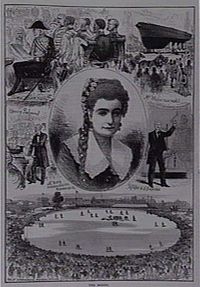
The game spreads to the Australian colonies
Gradually the game – known at first as "Melbourne Rules" became "Victorian Rules" and then "Australasian Rules" following its spread from Victoria into other Australian colonies, beginning with South Australia (1860), Tasmania (1864), Queensland (1866) and New Zealand (1876). In 1877, the sport's first governing bodies, the South Australian Football Association and the Victorian Football Association were formed on the 30th of April and the 7th of May respectively. The game began to be played in New South Wales in 1877, in Western Australia in 1881 and the Australian Capital Territory in 1911. By 1916, the game was first played in the Northern Territory, establishing a permanent presence in all Australian states and mainland territories.
The precursors of the South Australian National Football League (SANFL) and the West Australian Football League (WAFL) were strong, separate competitions by the 1890s. However late in the century the code began to in New South Wales and Queensland largely due to interstate rivalries and the lack of strong local governing bodies. In the case of Sydney, denial of access to grounds and the loss of professional players to other football codes directly inhibited to the game's growth.
The first intercolonial match had been played between Victoria and South Australia on August 2nd, 1879.
A rift in the VFA led to the formation of the Victorian Football League (VFL), which commenced play in 1897 as an eight-team breakaway of the stronger clubs in the VFA competition. By 1925, the VFL consisted of 12 teams, and had become the most prominent league in the game.
Effects of the two world wars
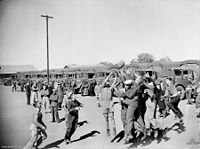
- Further information: The VFL during the World Wars and VFL/AFL players who died in active service
Both World War I and World War II had a devastating effect on the sport of Australian Rules. While scratch matches were played by Australian "diggers" in remote locations around the world, the game lost many of its great players to wartime service. Some competitions never fully recovered. World War I saw the game in New Zealand go into recess for three quarters of a century. In Queensland, the state league went into recess for the duration of the war. VFL club University left the league and went into recess due to severe casualties. The WAFL lost two clubs and the SANFL was suspended for one year in 1916 due to heavy club losses. The ANZAC Day clash is one example of how the war continues to be remembered in the football community.
Interstate Football and the Australian National Football Council
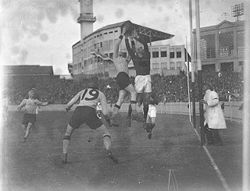
- Further information: interstate matches in Australian rules football
The Australian National Football Council's primary role was to govern the game at national level to facilitate interstate representative and club competition.
The ANFC ran the Championship of Australia, the first national club competition which was first run in 1888 and saw clubs from different states compete on an even playing field. During this time, the Port Adelaide won a record 4 national club championships. Although clubs from other states were at times invited, the final was almost always between the premiers from the two strongest state competitions, - South Australia and Victoria - and the majority of matches were played in Adelaide at the request of the SANFL. By the 1960s, as VFL clubs increasingly recruited the best players from other states, they began to dominate the competition and the last match was played in 1976, with North Adelaide being the last non-Victorian winner in 1972. Between 1977 and 1987, the Australian Football Council (AFC) in conjunction with the VFL ran a night series which invited clubs and representative sides from around the country to participate in the "National Football League" for the Wills Cup, however Victorian sides still dominated.
With the lack of international competition, representative matches between state teams were regarded with great importance. Originating from the early intercolonial matches, these tests continued well after Federation of Australia in 1901 and the Australian Football Council co-ordinated regular interstate carnivals. In 1908, a Jubilee Australasian Football Carnival was held to celebrate 50 years of football. The carnival included teams from Victoria, South Australia, Queensland, New South Wales, Tasmania and New Zealand.[24] Again, due primarily to the VFL recruiting the best players, Victoria dominated interstate matches for three quarters of a century. Representative football was kept alive longer than the national club competition with the introduction of State of origin rules in 1977. The new rules mean that rather than representing the state of their adopted club, players would return to play for the state they were first recruited. This instantly broke Victoria's stranglehold over state titles and Western Australia and South Australia began to win many of their games against Victoria. Both New South Wales and Tasmania scored surprise victories at home against Victoria in 1990.
Towards a National Club Competition

In 1978, the term Barassi Line was used to describe the football dichotomy that had emerged in Australia over three quarters of a century and also the first suggestion of regular interstate club competition or national league.
By 1980 in the space of just 25 years, the way the game was played had changed dramatically, with the phasing out of many of the game's kicking styles, changing rules and the influence of the handballing game and television.[25]
In 1982, in a move which heralded big changes within the sport, one of the original VFL clubs, South Melbourne, relocated to the rugby league stronghold of Sydney and became known as the Sydney Swans. In the late 1980s, strong interstate interest in the VFL led to a more national competition; two more non-Victorian clubs, the West Coast Eagles and the Brisbane Bears began playing in 1987. In their early years, the Sydney and Brisbane clubs continued to struggle both on and off-field and the AFL had to bail both out financially and grant significant draft concessions to keep them competitive.
The league changed its name to the Australian Football League (AFL) following the 1989 season. In 1991, it gained its first South Australian team, Adelaide. During the next five years, two more non-Victorian teams, Fremantle and Port Adelaide, joined the league. The AFL, currently with 16 member clubs, is the sport's elite competition and the most powerful body and continues to seek further opportunities to expand into new markets.
Following the emergence of the Australian Football League, the SANFL, WAFL and other state leagues rapidly declined to a secondary status. Apart from these there are many semi-professional and amateur leagues around Australia, where they play a very important role in the community, and particularly so in rural areas. The VFA, still in existence a century after the original schism, merged with the former VFL reserves competition in 1998. The new entity adopted the VFL name and remained a primarily state based competition.
State of origin games also declined in importance, especially after an increasing number of withdrawals by AFL players. The AFL turned its focus for representation to an annual International Rules Series against Ireland in 1998 before abolishing State of Origin in 1999. The second-tier state and territorial leagues still contest interstate representative matches.
Although Tasmanian AFL Bid has been ongoing, rather than pursue a national competition, the AFL's focus has become gaining marketshare in lucrative and broadcasting rights in the more populous Australian states and has advanced plans to create football franchises on the Gold Coast, Queensland (Gold Coast Football Club) and in Greater Western Sydney (Western Sydney Football Club). The AFL regularly schedules pre-season exhibition matches in all Australian states and territories as part of the Regional Challenge.
Australian football internationally
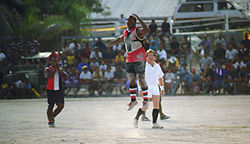
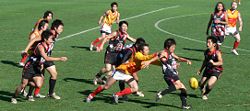
Whilst Australian rules football is played professionally only by men in Australia and is a major spectator sport only in Australia and Nauru, it is played at an amateur level in various countries around the world. Over 30 countries are home to clubs or leagues who play regularly, with around 20 that have either affiliation or working agreements with the AFL.[26] Although semi-professional players have come from outside of Australia, and there have been several players in the VFL/AFL who were born outside Australia, no player to learn the game overseas has yet played a game in the Australian Football League.
In the late 19th and early 20th centuries, the game spread through Australian emigration to areas such as New Zealand and South Africa, however this growth went into rapid decline following World War I. After World War II, the sport experienced a small amount of growth in the Pacific region, particularly in Nauru, Papua New Guinea and later New Zealand.
Most of the current amateur clubs and leagues in existence have developed since the 1980s, when leagues began to be established in North America, Europe and Asia. Initially the sport has grown with the Australian diaspora, aided by multiculturalism and assisted by exhibition matches and players who have converted to and from other football codes. In Papua New Guinea, New Zealand, South Africa and the United States there are many thousands of players. Great Britain, Canada, Japan, Denmark and Sweden have also shown strong potential in the sport amongst local players in the lead up to the 2008 Australian Football International Cup.
The AFL became the defacto governing body when it pushed for the closure of the International Australian Football Council in 2002.
International Rules Football
Since 1967 there have been many matches between Australian rules football teams (mainly from Australia) and Gaelic football teams (mainly from Ireland), under various sets of hybrid, compromise rules known as International rules football. In 1984, the first official representative matches of International Rules were played, and these were played annually each October between the AFL and the Gaelic Athletic Association between 1998 and 2006 as part of the official International Rules Series which attracted large crowds and media interest in both Ireland and Australia.
Australian rules football culture
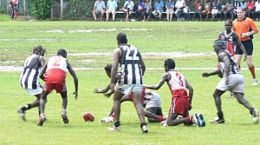
- See also: Australian rules football in Australia and Barassi Line
Australian Rules is a sport rich in tradition and Australian cultural references, especially surrounding the rituals of gameday for players, officials and supporters.
Australian rules football has attracted more overall interest among Australians (as measured by the Sweeney Sports report) than any other football code, and, when compared with all sports throughout the nation, has consistently ranked first in the winter reports, and most recently third behind cricket and swimming in summer.[27]
In 2006, a total of 615,549 registered participants played Australian football in Australia.[28] Participation 7.84% between 2005-06.[28] The Australian Sports Commission statistics show a 42% increase in the total number of participants over the 4 year period between 2001-2005.[29]
Australian rules football is played in more than 30 countries around the world.[13] In 2004, there were a total of over 25,000 participants outside of Australia.[30] This has grown to about 35,000 people in 32 countries playing in structured competitions outside of Australia[31] Australian rules is the national sport of Nauru.[32]
Many related games have emerged from football, mainly with variations of contact to encourage greater participation. These include Kick-to-kick (and its variants such as 'Markers Up'), Auskick, Rec Footy, Women's Australian rules football, 9-a-side Footy, Masters Australian Football, handball and longest-kick competitions. Players outside of Australia sometimes engage in related games on the available fields, like Metro Footy (played on gridiron fields) and Samoa Rules (played on rugby fields).
Australian Football Hall of Fame
For the centenary of the VFL/AFL in 1996, the Australian Football Hall of Fame was established. In that year 136 identities were inducted, including 100 players, 10 coaches, 10 umpires, 10 administrators and six media representatives.[33]
The selections have caused some controversy, mainly because of the predominance of VFL players at the expense of those who played in other leagues in the years before there was a national competition.
The elite Legend status was bestowed on 12 members of the Hall of Fame in 1996: Ron Barassi, Haydn Bunton Senior, Roy Cazaly, John Coleman, Jack Dyer, Polly Farmer, Leigh Matthews, John Nicholls, Bob Pratt, Dick Reynolds, Bob Skilton and Ted Whitten (see above list for further details).
The following ten members have been promoted to the status of "Legend" since 1996: Ian Stewart (1997), Gordon Coventry (1998), Peter Hudson (1999), Kevin Bartlett (2000), Barrie Robran (2001), Bill Hutchison (2003), Jock McHale (2005), Darrel Baldock (2006), Norm Smith (2007) and Alex Jesaulenko (2008).[34]
References
- ↑ http://afl.com.au/Portals/0/afl_docs/2007_LAWS_OF_THE_GAME.pdf (pg 10)
- ↑ In some special situations such as the 1977 VFL Grand Final or other such knock out situations, if the score is tied, either extra time or a Rematch the following week is required to get a result
- ↑ http://afl.com.au/Portals/0/afl_docs/2007_LAWS_OF_THE_GAME.pdf (pg 51)
- ↑ History Official Website of the Australian Football League
- ↑ http://www.abs.gov.au/AUSSTATS/abs@.nsf/ProductsbyReleaseDate/E298CEE24565C911CA256DEF007248FF?OpenDocument
- ↑ http://www.abs.gov.au/AUSSTATS/abs@.nsf/DetailsPage/4174.02005-06?OpenDocument
- ↑ For a detailed history of the evolution and development of the finals system used by the Victorian Football League (VFL) and, later, by the Australian Football League (AFL) see Early VFL Final systems and McIntyre System.
- ↑ The Australian Game of Football. Melbourne: Geoff Slattery. 2008. pp. 398. ISBN 9780980346664.
- ↑ http://mm.afl.com.au/afl_archive/cp2/c2/webi/article/304261bn.pdf
- ↑ http://www.aflnt.com.au/_content/document/00054633-src.pdf (pg 7)
- ↑ Australian Institute of Sport - Australian football
- ↑ http://afl.com.au/Portals/0/afl_docs/2007_LAWS_OF_THE_GAME.pdf (pg 3)
- ↑ 13.0 13.1 International - Official Website of the Australian Football League
- ↑ The McClelland Trophy
- ↑ AFL Explained - Official Website of the Australian Football League
- ↑ "Letter from Tom Wills". MCG website. Retrieved on 2006-07-14.
- ↑ pg 36. Melbourne FC Since 1858 - An Illustrated History
- ↑ 18.0 18.1 Ken Piesse (1995). The Complete Guide to Australian Football. Pan Macmillan Australia. ISBN 0-330-35712-3. p303.
- ↑ Scotch College - Cordner-Eggleston Cup
- ↑ Thomas Smith himself made this claim in response to an article about the history of Melbourne FC in The Australasian published February 26, 1876 (from Melbourne FC Since 1858 - An Illustrated History pg 36). Smith's personal account mentions Thompson arriving after the decision to form the club
- ↑ Harrison's involvement in the early stages is believed by many to be due to him being perceived as the "father of the game" in later decades and subsequent erroneous reporting
- ↑ pg 20-10. Melbourne FC Since 1858 - An Illustrated History. Goeff Slattery Publishing
- ↑ G.M. Hibbins Sport and Racing in Colonial Melbourne: The Cousin and Me - Colden Harrison, Tom Wills and William Hammersley Lynedoch 2007 chs 8,9
- ↑ A False Dawn
- ↑ WICKS, B. M. Whatever Happened to Australian Rules ? Hobart, Tasmania, Libra Books. 1980, First Edition. (ISBN 0909619069)
- ↑ AFL International Development
- ↑ Media Release, Sweeney Sport report for 2006-07
"If you can kick it, Australia will watch it", The Sydney Morning Herald (2003-05-22). - ↑ 28.0 28.1 More chase Sherrin than before
- ↑ http://www.ausport.gov.au/scorsresearch/ERASS2005/ERASS2005_findings.pdf Participation in Exercise, Recreation and Sport Survey 2005 Annual Report
- ↑ http://www.worldfootynews.com/article.php?story=20050301074107992 World Footy Census
- ↑ Curtis, R. (2008) "Pacific nations bemoan AFL neglect", The Sunday Age, 11 May 2008
- ↑ Team Profile: Nauru Chiefs
- ↑ AFL Hall of Fame and Sensation
- ↑ Legends - Official Website of the Australian Football League
See also
|
|
External links
- Laws of Australian Football 2008
- Australian Football explained in 17 languages - a publication from AFL.com.au
Official sites
- Australian Football League (AFL) official site
- Aussie Rules International
- Masters - Australian Football for the over 30s
- Australian Institute of Sport AFL website
- Australian Sports Commission website
Video
- Footypedia - Covers local footy history
- Full Points Footy - comprehensive history site
|
||||||||||||||||||||||||||
|
||||||||
|
|||||||||||||||||
|
||||||||||||||||||||||||||||||||||||||||||
|
|||||||||||||||||